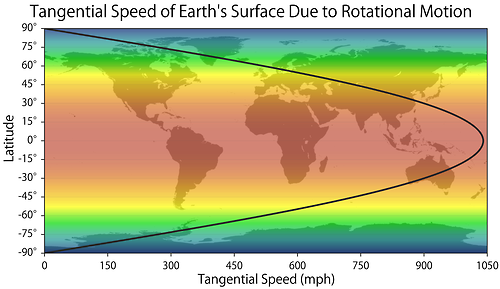As the World Turns
Starting in December of 1968, whenever the United States sent a manned spacecraft into space, it did so from Cape Canaveral, Florida, with the flight directed by the Kennedy Space Center located on nearby Merritt Island. Both the launch site and the Space Center are located an hour east of Orlando, on the Atlantic Ocean. They are nearly 1,000 miles (1,600 km) from the Lyndon B. Johnson Space Center in Houston, which acts as mission control soon after a shuttle takes flight. They are even further from NASA’s White Sands Test Facility in New Mexico, where many astronauts train; that site is about 1,750 miles (2,800 km) away.
Given these distances and the fact that Merritt Island, at least, is probably home to more alligators than people, the region seems like a strange place for a launch site. So why does NASA launch rockets from the Florida coast?
Blame the spin of the Earth.
Most schoolchildren know that the Sun rises in the east and sets in the west. This is a bit erroneous as the Sun, relative to the Earth at least, doesn’t move. The Earth rotates eastwardly around its vertical axis, causing the illusion that the Sun rises in the eastern sky. That eastwardly spin impacts travel to Earth’s orbit or beyond. As Space.com notes, “any rockets leaving Earth’s surface and traveling eastward get a boost from the Earth’s spin. A West Coast location would either send rockets over populated areas or have to contend with launching against the direction of the spin.” Overcoming the spin is difficult and costly, and why not use it to one’s advantage? An East Coast location seemed the best option.
But why Florida? It was chosen because it is as far south as one gets in the continental United States — or, more correctly, as close as the eastern seaboard of the United States gets to the Equator.

As seen in the graph above (from here, with the math explained), as latitudes get close to the Equator, the speed those of us on the ground are moving, relative to the Earth’s rotational axis, increases. At the Poles, the tangential speed is nil; at the Equator, it’s 1,050 miles per hour (just shy of 1,700 km/hr). Everything in Florida is flying around the Earth’s rotational axis at about 900 to 950 miles per hour. And when your ultimate destination isn’t spinning with the Earth — say you are off to the International Space Station or the Moon — getting a few hundred miles per hour head start sounds like a great idea. Quite literally, Florida is helping fling these vehicles into orbit or beyond a lot more than, say, Maine is.
Bonus Fact: At times, the Earth’s axis moves. It takes a big event, like an earthquake, though, to cause this. As NASA reported in 2011 after a major earthquake hit Japan, the Earth’s axis shifted by 6.5 inches (17 cm). NASA notes that the change causes the Earth “to wobble a bit differently as it rotates,” although none of us standing on its surface would really notice.
From the Archives: Umbrella Lottery: The main story isn’t related to the above (but it tells you what a 60% chance of rain means, so that’s interesting, right?). The bonus fact talks about NASA’s Vehicle Assembly Building at the Kennedy Space Center.
Take the Quiz: Can you pick NASA’s manned missions while avoiding their unmanned programs?
Related: “There’s No Place Like Space: All About our Solar System,” part of the Dr. Seuss learning library (but not written by Dr. Seuss himself, sadly). 4.5 stars on 73 reviews.
Image via Seth Kadish, used with permission.
